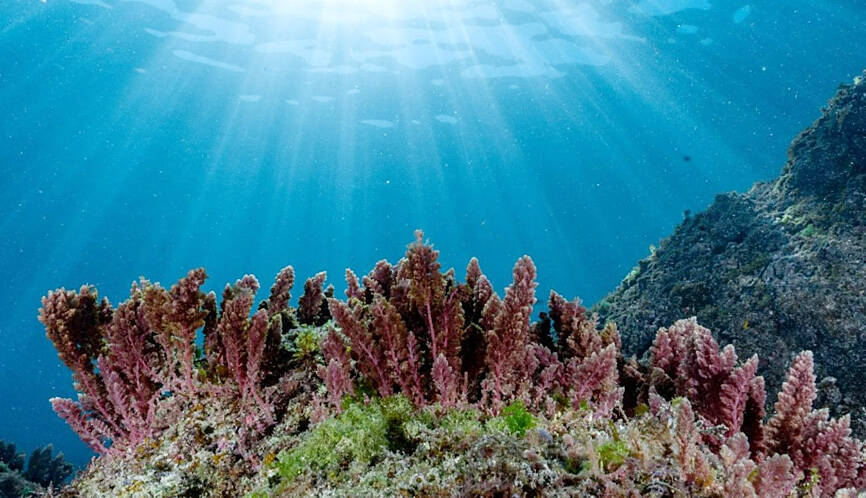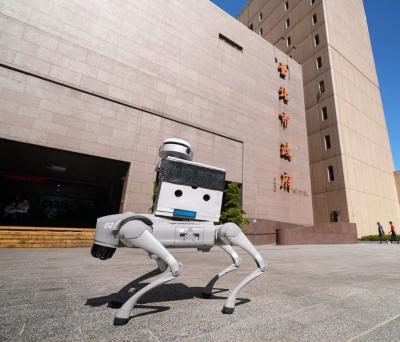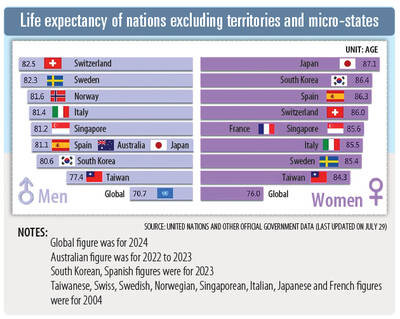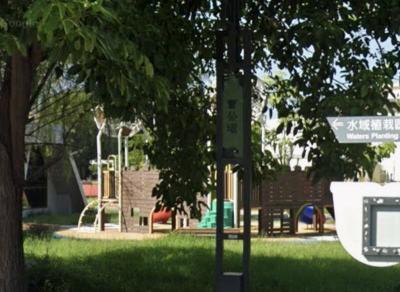The Fisheries Research Institute has developed an aquaculture technique that could mass produce tetrasporophytes of red sea plume, a seaweed that could significantly reduce methane emissions from ruminants, which is in line with the nation’s goal of net zero by 2050.
Research showed that cattle-produced methane could be reduced by up to 90 percent simply by adding 1 percent of dried red sea plume to cattle feed, the institute said.
Institute research fellow Hsu Tzu-yan (許自研) yesterday said that previously adopted techniques of cultivating red sea plume under artificial conditions invariably failed during the mass production process.

Photo courtesy of the Fisheries Research Institute via CNA
That was a challenge for the research team until the seaweed’s tetrasporophytes were identified and used in place of gametophytes, which were collected from natural environments or grown in simulated environments for research.
“While gametophytes die off in summers due to high temperatures, tetrasporophytes of red sea plume are alive year-round and are easier to grow under artificial conditions,” Hsu said.
“However, these threadlike tetrasporophytes are small and usually intertwined with other algae, making them much more difficult to discern and collect in the wild,” he said, adding that about 100g of tetrasporophytes are harvested per person per day in natural sea environments.
The institute focused its research on mass producing tetrasporophytes of red sea plume and found that rough algae prevented red sea plume from proliferating.
“We finally developed a technique that could purify the aquaculture environment by inhibiting or removing competing rough algae to maintain the dominant ratio of red sea plume,” Hsu said.
With the technique, the amount of cultivated tetrasporophytes could be boosted by 300g to 700g per tonne of seawater, he added.
Red sea plume is rich in bromides, an active substance that could effectively decrease methane emissions from ruminants, Hsu said, adding that tetrasporophytes contain higher levels of bromides than gametophytes.
Data from an in vitro rumen fermentation showed that at the same dose level of 0.5 percent, red sea plume gametophytes cultivated by the institute inhibited 98.3 percent of methane, while gametophytes collected from the wild inhibited 91.24 percent.
The inhibition rate of gametophytes climbed further to 99.82 percent after the dose was raised to 1 percent, it showed.
Animal testing also showed that methane produced by cattle burps could be reduced by 60 percent with only 0.15 percent of red sea plume incorporated into cattle feed.
The mass production technique has been transferred to a domestic biotech company, marking the beginning of the integration of ocean technology into the livestock industry, the institute said.
The technique not only advances low-carbon feed production technology, but would also help the development of low-carbon dairy products, it said.

The inspection equipment and data transmission system for new robotic dogs that Taipei is planning to use for sidewalk patrols were developed by a Taiwanese company, the city’s New Construction Office said today, dismissing concerns that the China-made robots could pose a security risk. The city is bringing in smart robotic dogs to help with sidewalk inspections, Taipei Deputy Mayor Lee Ssu-chuan (李四川) said on Facebook. Equipped with a panoramic surveillance system, the robots would be able to automatically flag problems and easily navigate narrow sidewalks, making inspections faster and more accurate, Lee said. By collecting more accurate data, they would help Taipei

TAKING STOCK: The USMC is rebuilding a once-abandoned airfield in Palau to support large-scale ground operations as China’s missile range grows, Naval News reported The US Marine Corps (USMC) is considering new sites for stockpiling equipment in the West Pacific to harden military supply chains and enhance mobility across the Indo-Pacific region, US-based Naval News reported on Saturday. The proposed sites in Palau — one of Taiwan’s diplomatic allies — and Australia would enable a “rapid standup of stored equipment within a year” of the program’s approval, the report said, citing documents published by the USMC last month. In Palau, the service is rebuilding a formerly abandoned World War II-era airfield and establishing ancillary structures to support large-scale ground operations “as China’s missile range and magazine

STATS: Taiwan’s average life expectancy of 80.77 years was lower than that of Japan, Singapore and South Korea, but higher than in China, Malaysia and Indonesia Taiwan’s average life expectancy last year increased to 80.77 years, but was still not back to its pre-COVID-19 pandemic peak of 81.32 years in 2020, the Ministry of the Interior said yesterday. The average life expectancy last year increased the 0.54 years from 2023, the ministry said in a statement. For men and women, the average life expectancy last year was 77.42 years and 84.30 years respectively, up 0.48 years and 0.56 years from the previous year. Taiwan’s average life expectancy peaked at 81.32 years in 2020, as the nation was relatively unaffected by the pandemic that year. The metric

A 72-year-old man in Kaohsiung was sentenced to 40 days in jail after he was found having sex with a 67-year-old woman under a slide in a public park on Sunday afternoon. At 3pm on Sunday, a mother surnamed Liang (梁) was with her child at a neighborhood park when they found the man, surnamed Tsai (蔡), and woman, surnamed Huang (黃), underneath the slide. Liang took her child away from the scene, took photographs of the two and called the police, who arrived and arrested the couple. During questioning, Tsai told police that he had met Huang that day and offered to